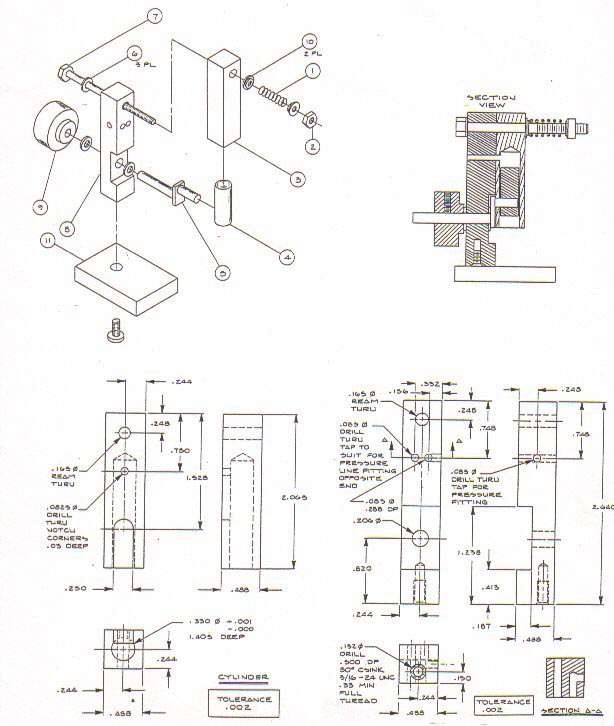|
Here are some plans for a model oscillating steam engine. We've build several of them with decent but unspectacular results (the "McCabe Runner" on my other page is less fussy about exact tolerances). Generally, we prefer the "Lucy" oscillating engine (free plans available elsewhere on the Web). We're not sure where these plans came from (photocopies were brought in by a student some time ago).There is a second page of plans to this engine from the main e-Zee (Little) Steam Engine Page - - Notes on this engine: It's not our favorite design....students have more trouble with these oscillators than the valve-type engines, because parts must fit more precisely...but they are pretty simple. We wouldn't make a one-piece crank. When we made this engine we used 1/8" gas welding rod for the round parts of the crankshaft...we silver soldered the pieces to a small plate with two 1/8" holes drilled in it (.276" apart)....bought low temperature "silver solder" from Home Depot (or try a hardware store)....works fine using a propane torch. One of our guys made a similar engine and he used "Crazy Glue" to hold the 1/8" rods to the plate! Also worked fine. Even though the crank in the drawing shows a "0.165 typ" pin, the piston hole to recieve it is 0.187". I assume this is a mistake in the print. We made it all 1/8" and it worked fine. The 0.165 reamed hole is intended to allow the 3/16-24 bolt to have a "perfect fit" with no slop. We didn't have any of these bolts on hand so we just used a #10-24 bolt. We measured the outside diameter of the bolt and drilled a hole that would allow the bolt to fit....we didn't use a ream. Can't recall the drill size we used....but as long as the bolt fits without too much "slop", it'll work. The idea of using a "pefect reamed" hole is a fussy detail that really isn't needed in these engines. Make sure to use a lightweight spring.....a strong one will add too much friction, especially if it is adjusted tight. You can make the slot in the cylinder bottom without a mill if you're careful. Drill a 1/4" hole into the cylinder 1.525 down from the top until it breaks into the bore....then carefully hacksaw out the piece and file it smooth. After drilling the bore, if a reamer isn't available, you can "hone out" the hole with a piece of sandpaper attached to a wooden dowel....spin the dowel in a power drill using a bit of oil. To make a piston that is "sized" to the correct diameter, you can get a piece of steel or brass stock (about 4" long) and "turn it down" by holding a file against it, while it is spinning in a power drill....keep checking to see if it will slide in the bore...when it does, you're finished. Then, just cut off the end of it for your piston. There is a "step" in the main frame part (called the "standard") that is 0.413 up from the base. You can "rough grind" this out with a small grinding wheel or Dremel tool and then file it to size....it takes patience, but it can be done. Probably the most important part of this engine is the positions of the air passage holes and the pivot point (where we used a 10-24 bolt). If these positions aren't correct, the thing won't run. We've been very successful making these holes with a hand-held electric power drill, as long as we have accurate center punched marks first. We found the flywheel on this engine to be a bit small...made the "standard" a bit taller for flywheel clearance and used a piece of 2" round aluminum. The bigger flywheel allows it to idle at a lower speed. You can "lap" the sliding surfaces of the "standard" and the cylinder together with toothpaste.....if these surfaces aren't smooth against each other, the motor will run poorly. Sometimes these engines won't start up right away due to a tiny flaw....engine must spin pretty freely to run. To help "break in" the engines, we hold the flywheel of the assembled engine against a buffing wheel....let the engine spin this way for several minutes until it spins nice and free. Usually, we try about 10 psi to get the engine running. They usually won't run on less than 5 psi, but some need as much as 40 psi at first, until fully broken in. Make sure engine is well lubricated in light oil. Wear safety glasses....they can blow apart if components fail! |
|
Oscillating Model Steram Engine (source:unknown) |
|
|
|
|
|
|
|
|
|
|
|
|
|
|
|
|
|
|

